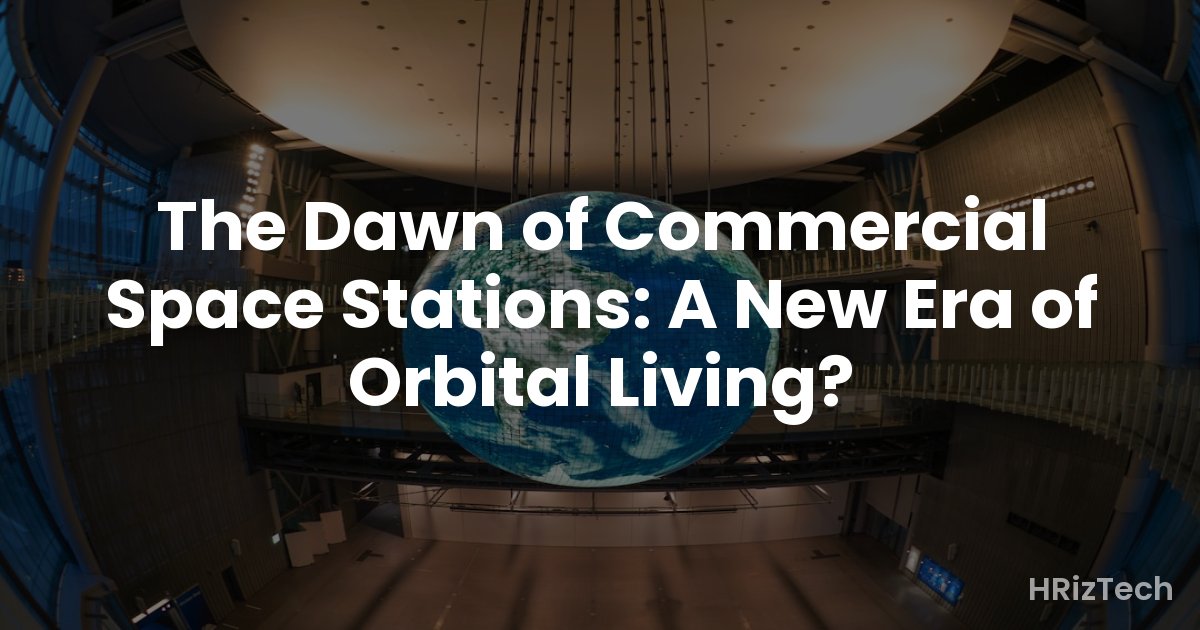The Dawn of Commercial Space Stations: A New Era of Orbital Living?

The Dawn of Commercial Space Stations: A New Era of Orbital Living?
- Private companies are leading the charge in developing commercial space stations.
- Orbital habitats offer potential benefits in research, tourism, and manufacturing.
- Significant challenges remain in terms of cost, safety, and regulation.
- The future of space stations could involve diverse collaborations and innovative technologies.
Leaving Low Earth Orbit Behind: From Government Monopoly to Private Enterprise
For decades, the realm of space stations was the exclusive domain of government agencies like NASA and Roscosmos. These behemoths, with their massive budgets and ambitious goals, built and maintained orbital outposts like Skylab and Mir, primarily for scientific research and international collaboration. But the landscape is changing. A new era is dawning, one driven by the ambition and innovation of private companies. Companies like Axiom Space, Blue Origin, and Orbital Assembly are spearheading the development of commercial space stations, promising a future where orbital living isn’t just for astronauts, but potentially for anyone with the means and the courage.
The Allure of Orbital Habitats: Research, Tourism, and Beyond
The potential applications of commercial space stations are vast and exciting. Beyond the continued scientific research into microgravity's effects on biological systems and materials science, the possibilities extend into several lucrative sectors:
Space Tourism: The Final Frontier for Luxury Travel?
Imagine waking up to the breathtaking view of Earth from your orbital hotel room, gazing at the swirling blues and greens of our planet against the stark blackness of space. This isn't science fiction anymore. Commercial space stations promise to open up space tourism to a wider audience, making the ultimate luxury travel experience a reality. While the price tag will undoubtedly remain steep for the foreseeable future, the allure of experiencing weightlessness, witnessing stunning celestial phenomena, and gaining a new perspective on our planet will undoubtedly attract a significant clientele.
Manufacturing in Microgravity: A New Industrial Revolution?
Microgravity environments offer unique advantages for manufacturing certain materials and products. The absence of gravity can lead to the creation of purer materials with improved properties, opening up possibilities in pharmaceuticals, advanced electronics, and even food production. Commercial space stations could become hubs for this new era of space-based manufacturing, potentially revolutionizing industries on Earth.
Scientific Research: Expanding the Frontiers of Knowledge
While government-funded research will undoubtedly continue to be a major driver of space station activities, commercial ventures will add another layer of innovation and opportunity. Private companies, often more agile and less burdened by bureaucratic processes, can quickly adapt to emerging research needs and develop new technologies to facilitate scientific breakthroughs in areas such as medicine, materials science, and astronomy.
Challenges and Considerations: The Road to Orbital Living Isn't Easy
Despite the exciting prospects, the path to widespread commercial space station operations is fraught with challenges. The most significant hurdle is undoubtedly the cost. Constructing, launching, and maintaining a space station requires a massive investment, putting it out of reach for all but the wealthiest companies and nations. This cost barrier could exacerbate existing inequalities, leading to concerns about accessibility and equity.
Safety and Regulation: Ensuring a Secure Orbital Environment
Ensuring the safety of astronauts and tourists in space is paramount. Commercial space stations must adhere to the highest safety standards, and robust regulations are needed to govern operations, prevent accidents, and mitigate risks. International cooperation will be crucial in establishing these standards and ensuring compliance.
The Legal Landscape: Navigating the Complexities of Space Law
The legal framework governing commercial activities in space is still evolving. Questions surrounding ownership, liability, and the application of national and international laws in orbit need to be addressed to provide a stable and predictable environment for private companies to operate. International collaborations and clear legal frameworks are essential to prevent disputes and ensure responsible space exploration.
The Future of Orbital Living: Collaboration and Innovation
The future of commercial space stations will likely involve a mix of public-private partnerships and innovative technologies. Government agencies will likely continue to play a role in funding research and providing regulatory oversight, while private companies will drive innovation and commercialization. The development of reusable launch systems, advanced materials, and efficient life support systems will be crucial in reducing costs and making orbital living more accessible.
We may also see the emergence of modular space station designs, allowing for expansion and customization as needed. This could lead to the creation of specialized modules for different purposes, from research labs to tourist accommodations to manufacturing facilities. The possibilities are truly limitless.
A New Dawn or a Distant Dream?
The development of commercial space stations marks a pivotal moment in the history of space exploration. It represents a shift from government-led initiatives to a more dynamic and commercially driven approach. While significant challenges remain, the potential benefits are undeniable. The future of orbital living is uncertain, but the journey has begun, and the possibilities are as vast and exciting as the cosmos itself.
What do you think are the biggest hurdles to overcome for widespread commercial space station adoption? Let's discuss in the comments below!
Comments
No comments yet. Be the first to comment!